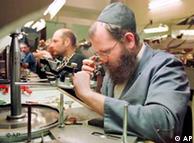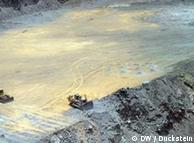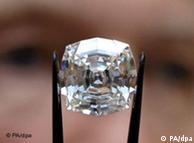Decimated Conflict Diamond Trade Survives in Europe
Over 99 percent of the world's supply of diamonds now comes from sources free of conflict, according to the World Diamond Council. However, many of those "blood" diamonds that remain find their way to Europe.
For years it has been accepted that precious stones from rebel-held mines in Africa have raised billions of dollars on world markets to finance insurgencies in countries such as Angola, Sierra Leone and the Democratic Republic of Congo (DRC) in violation of UN weapons and financial sanctions.
The "conflict" or "blood" diamond trade has recently grabbed the attention and imagination of the international community through dramatic real-life and fictional accounts of the effects it has on Africa. The publicity afforded blood diamonds has exposed them as the principle financing method for many civil wars and insurgencies raging on the African continent.
But a certification system called the Kimberley Process (KP) has done much to stem trade in conflict diamonds. Instituted by a coalition of governments, non-governmental organizations and the diamond industry in 2002, Kimberley requires rough diamonds to be sealed in tamper-resistant containers and have forgery-resistant, conflict-free certificates with unique serial numbers each time they cross an international border.
Difficulties applying international standards
 Civil wars and insurgencies have been funded by the trade
Civil wars and insurgencies have been funded by the trade
While the UN-backed Kimberley Process has virtually eliminated the trade in conflict diamonds, there are still nations which suffer from what the European Commission called "serious difficulties of implementation."
Countries such as Ghana, the Ivory Coast, Venezuela and Zimbabwe still operate outside Kimberley and their diamonds continue to be traded on the international market. The trail from these countries has led many investigators to Europe, much to the concern of the European Union and individual European countries where the diamond trade is an integral part of their economies.
The European Union was the biggest destination for rough diamond imports in 2005, taking in 39 percent of the total of legitimately produced diamonds in value terms. Most were destined for cutting in Antwerp, Europe's diamond capital and the leading trading center for rough, uncut diamonds, with about 70 percent of the EU imports passing through the Belgian port.
Blood diamonds still reaching Europe
 Even for experts, it can be nearly impossible to pick out blood diamonds
Even for experts, it can be nearly impossible to pick out blood diamonds
Some experts believe that despite a screening system introduced by the Antwerp World Diamond Center, a high percentage of blood diamonds still making it out of conflict zones are coming to Europe via Antwerp and other European diamond centers.
"The problem is that conflict diamonds very rarely come directly from the source country," said Annie Dunnebacke from non-governmental organization Global Witness' Conflict Diamond Campaign. "Rough and uncut diamonds can easily be smuggled over porous borders from places like the Ivory Coast and can obtain a Kimberley Process certificate from another country before being shipped to Europe."
Dunnebacke admitted that there is absolutely no doubt that conflict diamonds are on the European market, an assertion backed up by recent police investigations.
Smuggling rings smashed in Belgium, Switzerland
Investigators seized 14 million euros ($20 million) worth of diamonds believed to be from the Ivory Coast from a major diamond smuggling ring based in Antwerp in March. The on-going investigation also led to a number of Geneva-based firms that used fake certificates to import raw diamonds worth 370 million euros from countries outside the Kimberley Process before selling them to Belgian traders.
In 2004, eight Antwerp diamond traders were imprisoned for six years each after a similar investigation into a separate smuggling ring revealed that they had been involved in bringing uncut stones from Africa into Belgium.
 Merchants who think they're dealing in clean diamonds can be fooled by fake certificates
Merchants who think they're dealing in clean diamonds can be fooled by fake certificates
Antwerp dealers routinely settle multi-million dollar transactions in cash and rarely offer receipts, according to a study on diamonds and conflict in Sierra Leone by the Partnership Africa Canada NGO. While illegal operations have a hand in keeping the trade alive in Europe, even legitimate enterprises could be unwittingly involved.
"It is extremely difficult to distinguish one uncut diamond from another, making it easy to mix illicit diamonds with legal stones," said Michael Fleshman, from Africa Recovery, a department of the United Nations' Africa Office. "Moreover, the principal world market for uncut diamonds, Antwerp, is legendary for the laxity of its regulations on the handling of the stones -- making it virtually impossible to determine their origins and ownership."
Europe moves slowly to slam the door
Europe took a step closer to shutting down the trade last week at the fifth plenary session of the Kimberley Process, chaired by the European Commission. During the session, the signatories of the Kimberley Process called on countries with trading and manufacturing centers to carry out effective enforcement measures to ensure adequate government oversight over the trade of rough diamonds.
 The EU needs a pan-European database for traders, Dunnebacke said
The EU needs a pan-European database for traders, Dunnebacke said
Dunnebacke, however, said the EU needed to create a pan-European database of uncut diamond traders if it were to stand any chance of stopping the blood diamond trade within the bloc for good, since blood diamond traders targeted the EU states with laxer laws.
"While this is conjecture, it is believed that smugglers target European countries ... where regulations are less strict," she said, adding that Spain and Italy had some of the EU more lenient regulations. "You can't control all of the EU's borders, but if there was an EU trading list of people and businesses covered by the KP, then it would at least strengthen Europe's control of the conflict-diamond trade."
Decimated Conflict Diamond Trade Survives in Europe | Europe | Deutsche Welle | 15.11.2007

